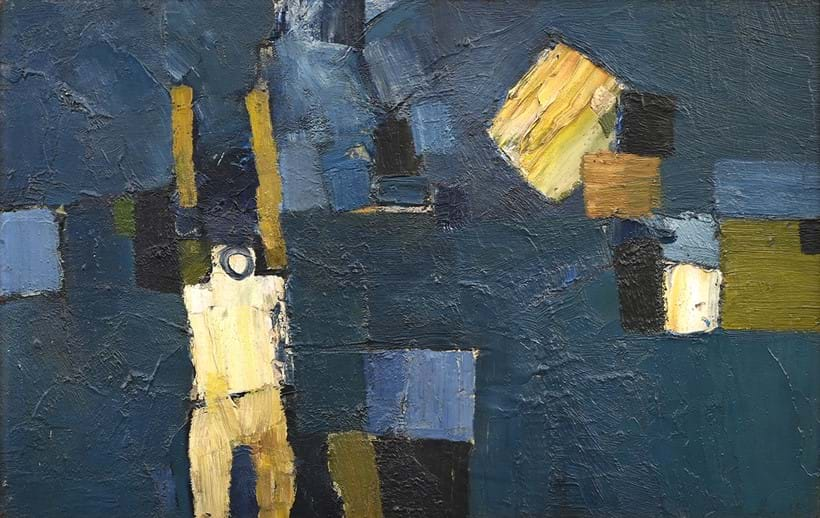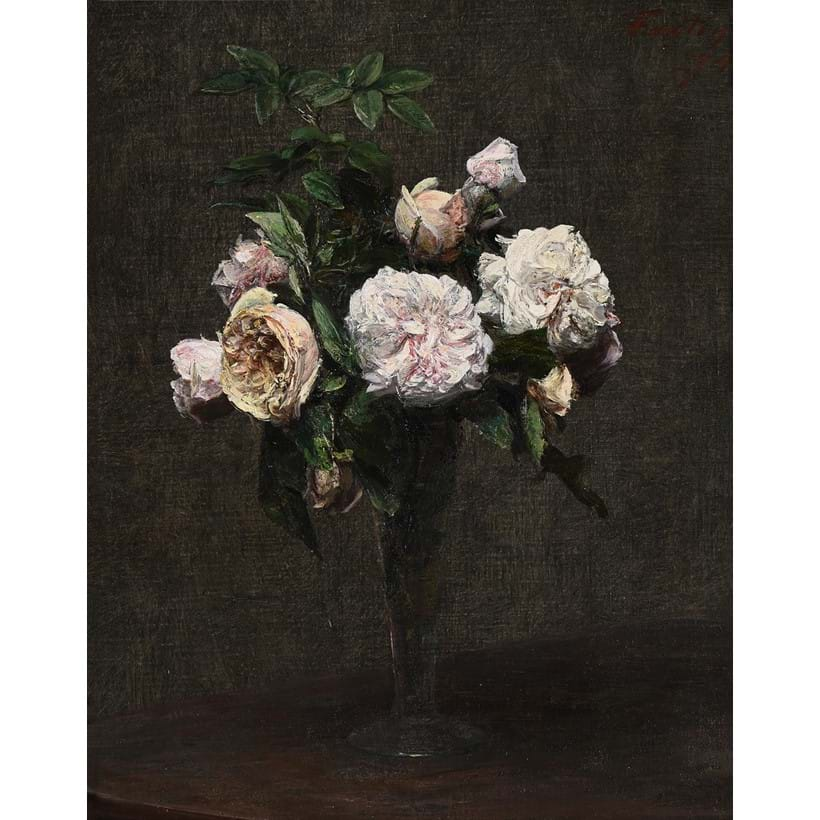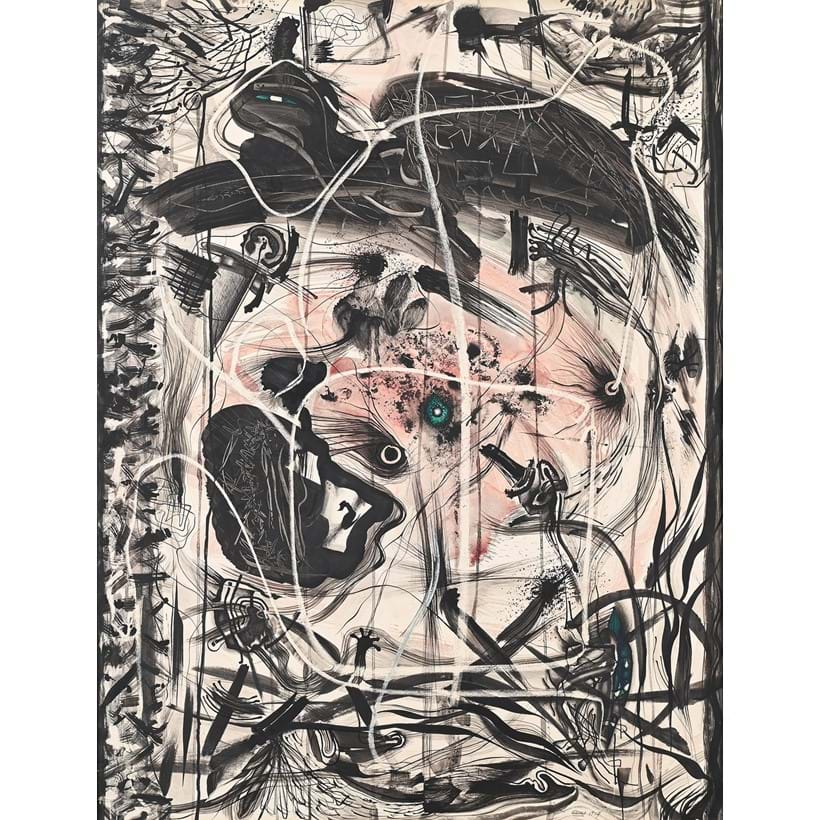Captivating Artistry: Lavery, Vaughan, Ossorio & More | Modern & Contemporary Art Auction | 13 March 2024
On Wednesday 13 March, we have our Modern and Contemporary Art auction. The auction features art spanning the 20th century up to the present day, including works by Sir John Lavery, Harold Harvey, Terry Frost, Roger Fry, Keith Vaughan and Henri Fantin-Latour. Here, we take a look at some of the highlights.
Keith Vaughan (1912-1977)
Gracing the cover of the catalogue, we have Lot 104, Blue Landscape with Figure by British artist Keith Vaughan. This work was originally purchased from the Crane Kalman Gallery, London in 1968, and included in Hepworth and Massey's 2012 publication, Keith Vaughan - The Mature Oils 1946-1977.
Vaughan was best known for his muted abstractions of male nudes, landscapes and architecture. In the 1940s, he was one of the leading artists of the Neo-Romanticism movement. Describing his own work in Journal and Drawings 1939-1965 (1966), Vaughan said "My problem is to find an image which renders the tactile physical presence of a human being without resorting to the classical techniques of anatomical paraphrase. To create a figure without any special identity (either number or gender) which is unmistakably human: imaginative without being imaginary. Since it is impossible to conceive a human form apart from its environment, an image must be found which contains the simultaneous presence and interpenetration of each. Hence the closer and closer interlocking bombardment of all the parts, like electrons in an accelerator, until the chance collision, felt rather than seen, when a new image is born."

Henry Herbert La Thangue (1859-1929)
We then have Lot 35, this charming work titled The Cow Girl, painted circa 1888, by Henry Herbert La Thangue.

Kenneth McConkey, an expert on British, Irish and French art of the 19th and early 20th century, tells us more about this work. "Sunlight strikes the white apron of a young woman who drives a pair of Ayrshire calves to pasture under trees that line the edge of a barley field. Its brightness creates a verdant overhead canopy through which flashes of a clear blue sky can be seen. Confrontation with friendly, curious, but unpredictable creatures within a colourful spatial envelope lifts an otherwise unremarkable scene into something immediately arresting. A few simple comparisons with contemporary paintings of cowherds will instantly convince the spectator that Henry Herbert La Thangue's The Cow Girl is a radical departure from convention.
"Precedents were exclusively European, where artistic custom and practice dictated that such subjects, tackled in a minor key in the work of Anton Mauve, for instance, would appeal to Barbizon and Hague School collectors. Overlaid with a poetic vision in the work of J-F Millet, the peasant cowherd began to step forward and assume more heroic status, but it was only with Jules Bastien-Lepage and Léon Lhermitte that la vie rurale was reassessed in its entirety as a visual source book. Scale was increased, and naturalistic techniques applied to give the powerful sense of brutal reality - that of the école naturaliste. In Pauvre Fauvette, Lepage's country child is dressed in sackcloth on a cold, barren hillside under a leafless tree. She was, as George Clausen would later write, 'placed before us ... without the appearance of artifice, but as [she] lives.'
"Images like these were part of La Thangue's education. Whatever one painted, it had to be realized on-the-spot, in the open air, in order to convey what the artist described as 'the sentiment of nature'. The sensations of the moment should not be faked. For one alive to Impressionist innovation, the advice, in the artist's words, was simply 'to learn to record ... impressions with rapidity' and without preconception.'"
Henri Fantin-Latour (1836-1904)
Exquisite still life paintings are synonymous with the work of French artist Henri Fantin-Latour (1836-1904). Initially trained by his father who was also a painter, Fantin-Latour went on to study alongside Edgar Degas and Alphonse Legros at the Ecole des Beaux Arts in Paris in the 1850s. The artistic milieu in which he was surrounded comprised Edouard Manet, Pierre-Auguste Renoir and Claude Monet amongst many others that would go on to be instrumental in the Impressionist movement. Fantin-Latour's work at this time comprised many group portraits of his contemporaries, but it was his flower compositions that brought him both critical and commercial success.
Fantin-Latour prioritised simple compositions, focussing his energy on the intricate representation of each element of the flower. The result is almost always a sumptuously rendered harmony of colour imbued with a sublime delicacy and an unparalleled attention to detail. The more complex compositions with both flowers and fruit show him to be the worthy successor to Chardin and Courbet, bridging the artistic divide between Realism and Impressionism. We are pleased to present this work Roses Thé in our March auction (Lot 70).

Sir John Lavery (1856-1941)
Sir John Lavery is one of the most important Irish artists in history. Amongst a selection of his works in the auction, a particularly fascinating work is Lot 46, the original on-the-spot sketch for one of the most significant events for Ireland, The Hearing of the Appeal of Sir Roger Casement, which has never been seen before. This is the study for Lavery’s grand painting of The Court of Criminal Appeal London, 1916 (Government Art Collection), which is an encapsulation of the high drama surrounding the controversial court case of Roger Casement CMG (1864-1916), who was hanged for his participation in the Irish Nationalist revolt in Dublin in 1916.

Casement was an Irish-born high-profile diplomat, working for the British Foreign Office, who became well-known for his humanitarian interests (he was nicknamed the ‘father of twentieth-century human rights investigations’). He joined the British Colonial Service in Africa and was then appointed as a British consul there, a post he held for over 20 years. In 1904 he produced The Casement Report on the Congo, which detailed horrific accounts of beatings, kidnappings, mutilations and killings of the native people by soldiers of the Congo Administration of King Leopold II. He was knighted in 1911 for bringing this to parliament’s attention. His witnessing of the Boer War and his examination of the colonial atrocities against indigenous populations had affected him deeply and after retiring from consular service in 1913, his strong nationalist sympathies came to the fore. He decided to go back to his Irish roots, turning his attention to Irish republicanism and other separatist movements.
As the First world War broke out Casement looked to attain German military aid for the 1916 Easter Rising, whose aim was Irish independence and a rebellion against British rule in Ireland. He did this by recruiting Irish soldiers who were prisoners of war in Germany, promising them a salary to participate. He was arrested and convicted for high treason, which led to his execution at Pentonville prison in 1916 and on the same day was stripped of his knighthood. His body was not returned to Ireland until many years later, in what is thought to have been a symbolic goodwill gesture to set the political stage for the Anglo-Irish Free Trade Agreement in 1965. His remains were re-interred in Glasnevin Cemetery, Dublin on March 2nd 1965.
There was much interest in the case, with many high-profile individuals petitioning to save him from the death penalty. However, it was partly the discovery of what was known as ‘the black diaries’, detailing Casement’s participation in homosexual activities, that are said to have swayed public opinion. It has never been confirmed if the diaries were fabricated by the British government to diffuse the campaign for a reprieve, or whether they were in fact genuine, but they were circulated widely. As homosexuality was against the law at the time these diary entries had an inevitable effect on public opinion.
The full-scale painted version was proposed by the presiding judge, Sir Charles Darling 1st Baron Darling, PC (1849-1936). Having commissioned the artist to paint other portraits of his family and having seen the artist’s other publicly exhibited works, he invited him to capture the court proceedings. The finished final painting of the work was produced in Lavery’s studio and completed in 1931. It remained there until the artist’s death in 1941, when he left it to the nation. It hung firstly in the Royal Courts of Justice and in 1950 at the request of Sergeant Sullivan, who had been part of Casement’s defence team, it was lent to King’s Inn, Dublin.
Alfonso Ossorio (1916-1990)
The auction also includes two works by Filipino/American artist Alfonso Ossorio. Alfonso Ossorio was at the centre of the Abstract Expressionist and Art Brut movements which flourished during the 1950s. This passion for the arts and exploration of abstraction, alongside his close friends Jackson Pollock and Jean Dubuffet, was reflected in not only his own practice but also his collecting habits. Financially supported by his family, Ossorio established one of the earliest collections of Art Brut and Abstract Expressionism, helping to consolidate and promote the movements in America.

As an artist, his early pieces depicted the emotional turmoil of a young homosexual male with a deeply rooted Catholic upbringing, set against the backdrop of World War II. These emotions were vividly portrayed through highly detailed surrealist designs. Additionally, Ossorio's art drew inspiration from psychoanalyst Nandor Fodor's writings on sexuality, birth, and motherhood. The present lot reflects the work of Jackson Pollock, most notably a piece titled Pattern c. 1945 held in the Hirshhorn Museum and Sculpture Garden, Smithsonian Institution, Washington, D.C.
Arguably, Ossorio's collecting habits and socialite lifestyle have overshadowed his artistic capabilities. A turning point came in 2013 with the exhibition Angels, Demons and Savages: Pollock, Ossorio, Dubuffet curated by Dorothy Konsinski and Klauss Ottman at the Phillips Collection in Washington D.C. before travelling to New York. This exhibition placed Ossorio in the centre of Pollock and Dubuffet shining a light on the importance of his career as both an artist and collector.
View page turning catalogue
Auction Details
Wednesday 13 March, 10.30am GMT
Donnington Priory, Newbury, Berkshire RG14 2JE
Browse the auction
Sign up to email alerts
VIEWING:
- Viewing in London (highlights only):
- Monday 4 March: 10am-4pm
- Tuesday 5 March: 10am-4pm
- Wednesday 6 March: 10am-4pm
- Viewing in Newbury:
- Sunday 10 March: 10am-3pm
- Monday 11 March: 10am-4pm
- Tuesday 12 March: 10am-4pm
- Wednesday 13 March: 8.30am-4pm
- Remote viewing service | Available by appointment
- Dreweatts 360 Virtual Auction Tour | Available from Wednesday 6 March
- Light refreshments are usually available on viewing and sale days.
















